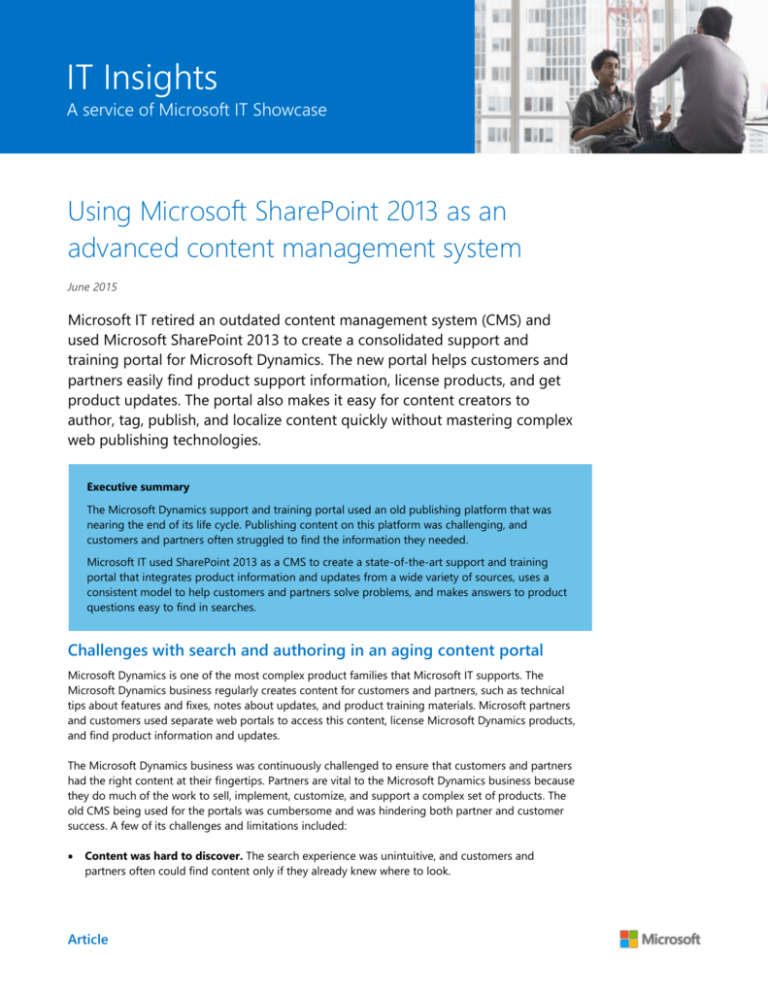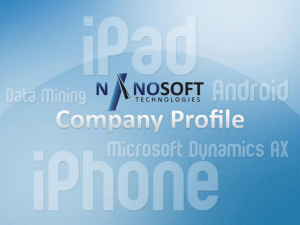
IT Insights
A service of Microsoft IT Showcase
Using Microsoft SharePoint 2013 as an
advanced content management system
June 2015
Microsoft IT retired an outdated content management system (CMS) and
used Microsoft SharePoint 2013 to create a consolidated support and
training portal for Microsoft Dynamics. The new portal helps customers and
partners easily find product support information, license products, and get
product updates. The portal also makes it easy for content creators to
author, tag, publish, and localize content quickly without mastering complex
web publishing technologies.
Executive summary
The Microsoft Dynamics support and training portal used an old publishing platform that was
nearing the end of its life cycle. Publishing content on this platform was challenging, and
customers and partners often struggled to find the information they needed.
Microsoft IT used SharePoint 2013 as a CMS to create a state-of-the-art support and training
portal that integrates product information and updates from a wide variety of sources, uses a
consistent model to help customers and partners solve problems, and makes answers to product
questions easy to find in searches.
Challenges with search and authoring in an aging content portal
Microsoft Dynamics is one of the most complex product families that Microsoft IT supports. The
Microsoft Dynamics business regularly creates content for customers and partners, such as technical
tips about features and fixes, notes about updates, and product training materials. Microsoft partners
and customers used separate web portals to access this content, license Microsoft Dynamics products,
and find product information and updates.
The Microsoft Dynamics business was continuously challenged to ensure that customers and partners
had the right content at their fingertips. Partners are vital to the Microsoft Dynamics business because
they do much of the work to sell, implement, customize, and support a complex set of products. The
old CMS being used for the portals was cumbersome and was hindering both partner and customer
success. A few of its challenges and limitations included:
Content was hard to discover. The search experience was unintuitive, and customers and
partners often could find content only if they already knew where to look.
Article
2 | IT Insights: Using Microsoft SharePoint 2013 as an advanced content management system
Business complexity confused users. With more than 15 disconnected websites and systems
required for a customer or partner to do business, there was no single entry point to bring these
systems together while isolating users from the business complexity.
Content did not display dynamically or contextually. All customers and partners who visited
the portal saw the same content, regardless of the Microsoft Dynamics products they used, and
they had to actively look for the product information that was relevant to them.
Simplicity of web operations for a complex business
Microsoft IT needed a platform that could scale and adapt to fit the changing needs of the Microsoft
Dynamics product team. After analyzing the existing content management system, reviewing
requirements for a proposed new system, and surveying the available tools with which to build it,
Microsoft IT determined that the most powerful, flexible CMS option available was SharePoint 2013.
Two of the most important platform goals were to enhance information discoverability for site visitors
and provide more flexible content authoring tools. Microsoft IT used the SharePoint 2013 searchdriven architecture to improve content discoverability with contextual search, and they took
advantage of the cross-site publishing feature of SharePoint 2013 to allow authors to create and
maintain content in one place and push it anywhere to be rendered automatically. Authors could
spend less time on the process of authoring and more time on creating content that is most relevant
to the needs of their customers and partners.
Surfacing discoverable, relevant content for customers
With the new CMS, users can visit either the partner portal or the customer portal and find content
from anywhere across 13 Microsoft Dynamics product sites, including variation sites and sub-webs,
for a total of 473 sites. By using SharePoint 2013 federated and contextual search features,
Microsoft IT delivered a search experience to customers and partners that is similar to familiar
consumer search engines such as Bing. The power of SharePoint 2013 to display product-based,
contextual information helped Microsoft IT create focused information-discovery tools to improve
self-support, which resulted in an approximately 10 percent reduction in support calls.
Flexible publishing platform for authors
The new flexible publishing platform can show internally and externally generated content and
external transitional content in one portal, and it decouples the authoring process from content
rendering. The SharePoint 2013 cross-site publishing feature can display single-source content across
both the partner and customer portals. Authors create and maintain content once in the authoring
portal; tagging and user context determine where the content is exposed in the customer and partner
portals.
Benefits
The enhanced search capabilities introduced with the new CMS delivered measurable benefits,
such as:
Improved partner satisfaction. Satisfaction among Microsoft partners increased by 15 percent,
measured by a fiscal 2015 worldwide partner satisfaction survey score improvement from 125
to 144.
Increased site visits. Site visits doubled within six months and increased by 120 percent overall.
Continued usage. The new platform replaced the old CMS as the most-used resource for
Microsoft Managed Partners, and the usage rate has increased from 78 to 81 percent.
Organic search results. Organic search results (through Bing and Google) increased from no
traffic to more than 22 percent of all traffic.
www.microsoft.com/ITShowcase
3 | IT Insights: Using Microsoft SharePoint 2013 as an advanced content management system
Benefits of the new platform’s advanced content authoring tools and improved user discoverability
include:
Money saved on support. Improved discoverability in the new customer and community portals
reduced the number of customer support incident tickets by about 65 percent. This saves
Microsoft at least $7 million per year in support costs, based on expected support-cost growth by
Microsoft Finance.
Faster searches for more satisfied site visitors. Faster, more precise searching has improved the
productivity of partners and customers who use the portal. Contextual search helps customers and
partners find precisely what they need without wasting time on irrelevant hits in search results.
Consistent user experience across platforms. The new platform consolidates and connects
diverse content sources, providing a consistent model for communicating with customers and
partners.
Quick response to market demand. The scalable, expandable architecture of the new platform
enables rapid adjustment to market demands, which allows the platform to match the speed of
the Microsoft Dynamics business.
Improved discoverability. The new platform displays dynamic, contextual content that
encourages user self-support. User search results are delivered and prioritized based on a user’s
current site location, consolidating the most relevant information from all Microsoft Dynamics
content sources.
Simplified authoring. The new platform increases author efficiency by letting authors create
content once and using it anywhere, resulting in a consistent authoring experience across all
Microsoft Dynamics products. Authors do not have to know anything about how content is
rendered, so they can concentrate on content, not formatting and positioning.
Resources
Overview of cross-site publishing in SharePoint Server 2013
https://technet.microsoft.com/en-us/library/jj635883.aspx
SharePoint at Microsoft course
http://www.microsoft.com/itshowcase/Courses/Classroom
SharePoint overview
http://products.office.com/en-us/sharepoint/sharepoint-2013-overview-collaboration-softwarefeatures
For more information
For more information about Microsoft products or services, call the Microsoft Sales Information
Center at (800) 426-9400. In Canada, call the Microsoft Canada Order Centre at (800) 933-4750.
Outside the 50 United States and Canada, please contact your local Microsoft subsidiary. To access
information via the World Wide Web, go to:
www.microsoft.com
www.microsoft.com/ITShowcase
© 2015 Microsoft Corporation. All rights reserved. Microsoft and Windows are either registered
trademarks or trademarks of Microsoft Corporation in the United States and/or other countries. The
names of actual companies and products mentioned herein may be the trademarks of their respective
owners. This document is for informational purposes only. MICROSOFT MAKES NO WARRANTIES,
EXPRESS OR IMPLIED, IN THIS SUMMARY.
www.microsoft.com/ITShowcase








